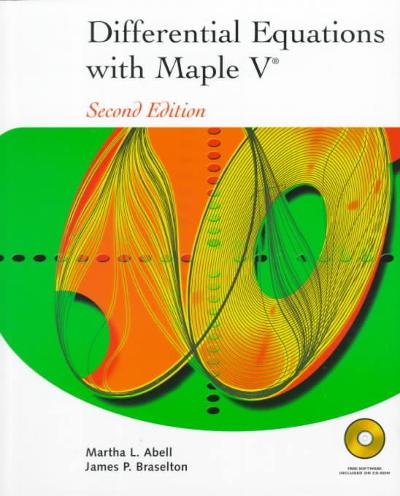Question
(1) Prove that if P(B) = 0 then B and A are independent for any event A. Prove the same if P(B) = 1. (2)
(1) Prove that if P(B) = 0 then B and A are independent for any event A. Prove the same if P(B) = 1.
(2) Roll two fair die and let X1, X2 be their values.
(a) Calculate P(X1 = 6|X1 + X2 = 10).
(b) Let A be the event that X1 > X2 and B the event that X1 + X2 = 7. Are A and B independent? (
c) Let FX1 (x) and FX1,X2 (s, t) be the marginal and joint distribution functions respectively. Calculate FX1 (4) and FX1,X2 (2, 3).
(3) Suppose P(A) = .6 and P(B) = .3. What are the largest and smallest possible values of P(A B)? What are the largest and smallest possible values of P(A B)?
(4) Suppose the probability of snow is .2 of rain is .5 and of sun is .3. Suppose that it's never warm when it snows, it's warm with probability .3 when it rains and .7 when it is sunny. (a) What's the probability that it is warm? (b) What's the probability of it being warm given that it's not sunny?
(5) If A and B are independent events, are Ac and Bc independent? Prove it or give a counterexample. What about A and Bc ?
(6) Let X1 and X2 be independent Unif[0, 1] random variables. Let X3 = X1 X2. (a) Compute EX3 (b) Compute var(X3) (c) Compute cov(X2, X3)
(7) Let U1, . . . Un be independent Unif[0, 1] random variables. Let p, q (0, 1) with p q. For j = 1, . . . n let Xj be the indicator random variable that Uj p and let Yj be the indicator random variable that Uj q. Let X = Pn j=1 Xj and Y = Pn j=1 Yj . Let Z = X Y .
(a) What are the marginal distributions of X and Y ?
(b) What is cov(Xj , Yj )?
(c) For i 6= j, what is cov(Xi , Xj )?
(d) What is cov(X, Y )?
(e) What is P[X Y ]?
(f) What is P[X = Y ]?
(g) What is the marginal distribution of Z?
(8) Let U Unif[0, ] and Y = sin(U). What is EY ?
(9) Let X1 and X2 be two independent geometric random variables with parameter p. Let Y = X1 + X2. Compute P(Y = 4).
(10) Let Y P ois(). Compute:
(a) P[Y = k|Y > 0] (for k > 0)
(b) E[Y (Y 1)(Y 2)]
(11) Throw m letters uniformly and independently at random into n boxes. Let Y be the number of empty boxes.
(a) Write Y as the sum of indicator random variables.
(b) Compute EY .
(c) Show that if m 2n log n then P[there is at least 1 empty box] 0 as n .
(12) Let Xn Bin(n, /n) and Y P ois(). Show that for each k 0, limn P[Xn = k] = P[Y = k] .
(13) Let X1, . . . , Xn be independent Ber(p) random variables and let M = max{X1, . . . , Xn}. Compute EM and var(M).
(14) Let Y1 and Y2 be iid random variables taking the values 1 and 1 with probability 1/2 each. Let Y3 = Y1Y2.
(a) Calculate EY1 and var(Y1). 3
(b) Calculate E Y3 and var( Y3).
(c) Are Y1 and Y3 independent?
(d) Are Y1, Y2, Y3 independent?
Step by Step Solution
There are 3 Steps involved in it
Step: 1

Get Instant Access to Expert-Tailored Solutions
See step-by-step solutions with expert insights and AI powered tools for academic success
Step: 2

Step: 3

Ace Your Homework with AI
Get the answers you need in no time with our AI-driven, step-by-step assistance
Get Started


